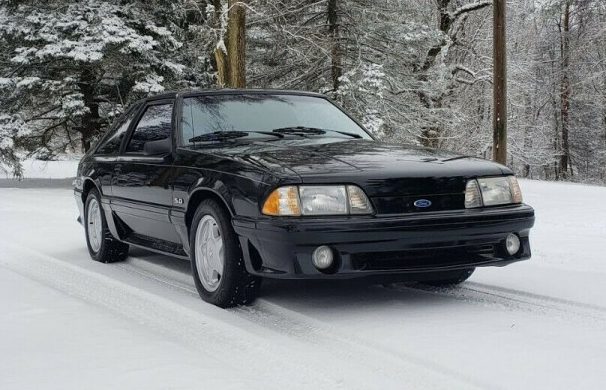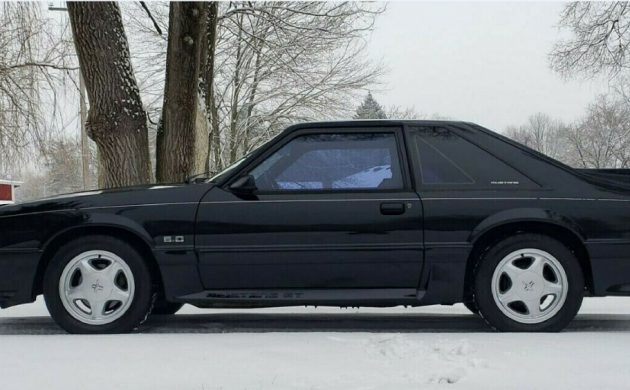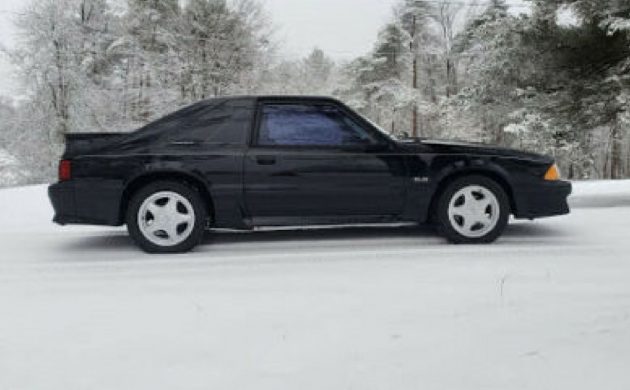Sometimes photo opportunities are too good to miss. This 1993 Ford Mustang GT usually spends the Winter months tucked away in a toasty garage. The owner chose to bring it out to shoot some photos for his listing. The contrast between the snow and the Mustang’s gleaming Black paint is striking. If that is enough to whet your appetite, you will find the Mustang located in Ada, Michigan, and listed for sale here on eBay. The bidding has now reached $12,900 off the back of some intense action. With the reserve met, a new home isn’t far away for this beauty.
There’s no doubt that photographing a Black car against a white backdrop will create a visual impact, and that is true with this Mustang. When you look beyond that, what you find is a 28-year-old classic that presents exceptionally well. Black is the perfect color for revealing ripples, dings, and other metal sins. In this case, everything looks very promising. The panels are straight, and the gaps are tight. The paint holds a beautiful shine, and there is no evidence of any rust problems. The plastic trim and spoilers display no visible cracking or damage, and the spotless alloy wheels provide a great contrast. There are no issues with the tinted glass, and when you look at the overall condition of the Mustang, it is easy to believe the owner’s assertion that the vehicle never comes out of its garage during the colder months.
While the exterior photos reveal a lot about the Mustang’s life and condition, the interior shots don’t tell us much. This is the better of the two that the owner supplies, which is disappointing. What can be seen looks promising, with no evidence of plastic or trim problems, and a new Rockford Fosgate CD player slotted into the spot where the original radio would have been. The owner admits that the driver’s seat has a slight lean on it, but he has a quote of $80 to address this. We can’t see the upholstery, but the owner claims that if the seats were cleaned and a set of floor mats were fitted, the interior would present in as-new condition. There is no wear on any of the upholstered surfaces, and the headliner is said to still be tight and clean. Comfort features include power windows, power locks, power mirrors, a driver’s airbag, and cruise control.
The owner doesn’t supply any engine photos, but he goes to great pains to explain that the Mustang is unmolested and in sound mechanical health. Under the hood is the venerable 5.0-liter V8, backed by a T-5 manual transmission. With 205hp on tap, the Mustang should gallop through the ¼ mile in 15.4 seconds. The owner claims that the vehicle has a genuine 88,700 miles on the clock but doesn’t indicate whether he holds evidence to verify this. The Mustang remains mechanically stock, although it has been fitted with a strut brace and welded sub-frame connectors. These are claimed to make the car feel more taut and responsive. I have fitted a strut brace to one of my vehicles in the past, and it does make a difference. Otherwise, the Mustang remains as it rolled off the production line. It has recently been treated to new brakes and new Koni shocks, along with a fresh dose of Mobil 1 oil in that sweet little V8. The vehicle is said to run and drive perfectly, and the owner had no issues kicking it into life for this photoshoot after many weeks of inactivity.
When the Mustang II broke cover, many enthusiasts believed that the Mustang would wither and die. When the Fox-Body broke cover as its replacement, its styling owed nothing to either its predecessor or to the original. However, it evolved throughout its lifetime to the point where it became clear that Ford was serious about recapturing the badge’s lost youth. This GT comes from that final year of production, and its performance credentials are an indication that Ford had achieved its goal. The Fox-Body Mustang continues to capture hearts, and in so doing, also captures wallets. Values are continuing to soar at an impressive rate, and if this trend continues, they have the potential to become distinctly less affordable with each passing year. If one of these has been on your shopping list, then now might be the time to bite the bullet. If that is the case, then I would be giving this one a close inspection. It could be the Mustang that you’ve been searching for.







Good write-up Adam. Plus what seems like a thorough and honest ebay description; a few deficiencies are listed, but “it feels more like an 8-year-old car.” It has many of the typical Fox Body durability and performance mods. Not low mileage but in overall good shape, so the bidding is solid.
This would make for a low-stress yet fun collector car. Like Adam said, I expect the popularity (and price) of these to keep going up.
Seeing that 205 HP number reminded me of the controversy back then. The ’87-’92’s all had a 225 HP rating. Then all of a sudden for the ’93 GT they rated it to 205. They really didn’t change anything that would reduce the power that year though. Some say is was because they knew the upcoming 4.6 was going to be 215 HP and they didn’t want to impact sales or negative reviews.
The camshafts kept getting milder from the ’87-’88 models along with the switch to mass air metering vs. speed density. They finally re-rated the engine to 205hp in 1993, and indeed, the later models were slower. Another reason for the re-rating might have been the Cobra only being rated at 235hp and most people likely wouldn’t want to pay a premium for what amounted to a 10hp bump. However, Ford actually seemed to underrate the ’93 Cobra by about 30-40hp and 30-40 lb-ft of torque.
https://www.motor1.com/news/410856/1993-ford-mustnag-svt-dyno/
I don’t believe I have ever read anything about camshaft changes. MAF is only better than SD because it can be dialed in better after mods are made. In stock form, they offer equal power. They both give the right amount of fuel that’s needed.
89-93 Stock 5.0 L H.O. cams were all IDENTICAL:
Stock 87-93 Cam Information:
Lift is .444*/.444* – Advertised @ 266*/266* until August of ’88, then it went to 276*/266* .
Duration at .050″ varies and ranges from 204*+/204*+
85-88:
Lift: .278 intake, .278 exhaust
Duration: 266 intake 266 exhaust
Overlap: 36 degrees, 9.04 factor
Lobe Center: 115 intake, 115 exhaust
89-90:
Lift: .278 intake, .278 exhaust
Duration: 276 intake, 266 exhaust
Overlap: 39 degrees, 19.51 factor
Lobe Center: 116 intake, 115 exhaust
91-93:
Lift: .278 intake, .278 exhaust
Duration: 276 intake, 266 exhaust
Overlap: 39 degrees, 19.51 factor
Lobe Center: 116 intake, 115 exhaust
1985 – 8/1988
I.O. 17 BTDC / I.C. 69 ABDC
E.O. 67 BBDC / E.C. 19 ATDC
8/1988 – 1993
I.O. 20 BTDC / I.C. 76 ABDC
E.O. 67 BBDC / E.C. 19 ATDC
Here are the Cobra Specs:
93-95 Cobra:
Lift: .282 intake, .282 exhaust
Duration: 270 intake, 270 exhaust
Overlap: 33.5 degrees, 15.24 factor
Lobe Center: 115 intake, 121.5 exhaust
Indeed so, Neil. The difference between the ’88 and ’89-90 models was that the ramp rates were slowed which looks some of the edge off (including noise).
IIRC, one of the magazines of the day did a comparison between a ’68 428CJ and a ’87 LX stripper, and they got the LX 5sp with 3.08’s into the high 13’s with a 1/4 tank of premium, 16 deg. timing, an iced intake, short belt, slicks and disconnected sway bar in the front. ’89-’93 models couldn’t pull that off (nor could that pristine 428CJ).
But the ’71 boss 351 could – fact stock – with bias plies, more weight, mechanical fan, pts/condensor & 4 speed.
At the time they said the rating was a more accurate rating system. Considering a Cobra made about 225-230 at the wheels, that’s pretty accurate.